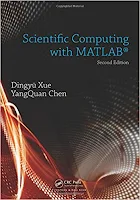MatLab: An Introduction with Applications
Rao V. Dukkipati ... 680 pages - Publisher: Anshan Publishers; (October, 2010) ... Language: English - ISBN-10: 1904798675 - ISBN-13: 978-1848290433
This book presents an introduction to MATLAB and its applications in engineering problem solving. It is designed as an introductory course in MATLAB for engineers. The classical methods of electrical circuits,control systems, numerical methods, optimization, direct numerical integration methods, engineering mechanics and mechanical vibrations are covered using MATLAB software. The numerous worked examples and unsolved exercise problems are intended to provide the reader with an awareness of the general applicability to electrical circuits, control systems, numerical methods, optimization, direct numerical integration methods, engineering mechanics and mechanical vibrations using MATLAB. Contents: MATLAB Basics - Electrical Circuits - Control Systems - Numerical Methods - Optimization - Direct Numerical Integration Methods - Engineering Mechanics - Mechanical Vibration.
This book presents an introduction to MATLAB and its applications in engineering problem solving. It is designed as an introductory course in MATLAB for engineers. The classical methods of electrical circuits,control systems, numerical methods, optimization, direct numerical integration methods, engineering mechanics and mechanical vibrations are covered using MATLAB software. The numerous worked examples and unsolved exercise problems are intended to provide the reader with an awareness of the general applicability to electrical circuits, control systems, numerical methods, optimization, direct numerical integration methods, engineering mechanics and mechanical vibrations using MATLAB. Contents: MATLAB Basics - Electrical Circuits - Control Systems - Numerical Methods - Optimization - Direct Numerical Integration Methods - Engineering Mechanics - Mechanical Vibration.


















